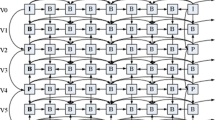Abstract
While progressive compression techniques were proposed long time ago, fast and efficient streaming of detailed 3D models over lossy networks still remains a challenge. A primary reason is that packet loss occurring in unreliable networks is highly unpredictable, leading to connectivity inconsistency and distortions of decompressed meshes. Although prior researches have proposed various methods to handle errors caused by transmission loss, they are always accompanied by additional costs such as redundant transmission data, bandwidth overloads, and result distortions. In this paper, we address this problem from a receiver’s point of view and propose a novel receiver-based loss tolerance scheme which is capable of recovering the lost data when streaming 3D progressive meshes over lossy networks. Specifically, we use some constraints during the model compression procedure on the server side, and suggest a prediction method to handle loss of structural and geometric data on the client/receiver side. Our algorithm works without any data retransmission or introducing any unnecessary protection bits. We stream mesh refinement data on reliable and unreliable networks separately so as to reduce the transmission delay as well as to obtain a satisfactory decompression result. The experimental results indicate that the decompression procedure can be accomplished quickly, suggesting that it is an efficient and practical solution. It is also shown that the proposed prediction technique achieves a very good approximation of the original mesh with low distortions, and in the mean time, error propagations are also well controlled.
















Similar content being viewed by others
References
Alliez P, Desbrun M (2001) Progressive compression for lossless transmission of triangle meshes. In: Proceeding of SIGGRAPH’01, pp 195–202
Alregib G, Altunbasak Y(2002) An unequal error protection method for packet loss resilient 3D mesh transmission. In: Proceedings of the IEEE International Conference, vol. 2. Orlando, FL, pp 2041–2044
Alregib G, Altunbasak Y (2004) 3TP: 3D models transport protocol. In: Proceedings of the 9th International Conference on 3D Web Technology, pp 155–162
Alregib G, Altunbasak Y, Rossignac J (2005) Error-resilient transmission of 3D models. ACM Trans Graph 24:182–208
Bischoff S, Kobbelt L (2002) Towards robust broadcasting of geometric data. Comput Graph 26:665–675
Cheng W, Ooi WT, Mondet S, Grigoras R, Morin G (2007) An analytical model for progessive mesh streaming. In: Proceedings of 15th ACM International Multimedia Conference, September 24–29, pp 737–746
Cignoni P, Rocchini C, Scopigno R (1998) Metro: measuring error on simplified surfaces. Comput Graphics Forum 17(2):167–174
Devililers O, Gandoin P (2000) Geometric compression for interactive transmission. In: Proceedings of IEEE Visualization, pp 319–326
Guan W, Cai J, Zheng J, Chen C (2008) Segmentation based view-dependent 3D graphics model transmission. IEEE Trans Multimedia 10(5):724–734
Hoppe H (1996) Progressive meshes. In: Proceedings of SIGGRAPH’96, pp 77–108
Karni Z, Gotsman C (2000) Spectral compression of mesh geometry. In: Proceedings of SIGGRAPH’00, pp 279–286
Kraevoy V, Sheffer A (2005) Template based mesh completion. In: Proceeding of Eurographics Symposium on Geometry Processing (SGP), pp 13–22
Li H (2007) Streaming 3D progressive meshes over lossy networks. Doctoral Thesis. University of Texas at Dallas
Li H, Li M, Prabhakaran B (2006) Middleware for streaming 3D progressive meshes over lossy networks. ACM TOMCCAP 2(4):282–317
Li H, Shan P, Prabhakaran B (2004) Smart decision module for streaming 3D meshes over lossy networks. In: Proceedings of DMS/VLC’04, pp 275–278
Li H, Tang Z, Guo X, Prabhakaran B (2008) Loss tolerance scheme for 3D progressive meshes streaming over networks. In: Proceedings of IEEE ICME, Germany, pp 501–504
Martin I (2000) Adaptive rendering of 3D models over networks using multiple modalities. Technical Report, IBM T. J. Watson Research Center RC 21722, 97821 (April)
Ohtake Y, Belyaev A, Alexa M, Turk G, Seidel H (2003) Multi-level partition of unity implicits. ACM Trans on Graphics 22(3):463–470
Pajarola R, Rossignac J (2000) Compressed progressive meshes. IEEE Trans Vis Comput Graph 6(1):79–93
Pfeifle R, Seidel H (1996) Trianglar B_Splines for blending and filling of polygonal holes. In: Proceeding of Graphics Interface ’96, Morgan Kaufmann Publisher, pp 186–193
Southern R, Perkins S, Steyn B, Muller A, Marais P, Blake E (2001) A stateless client for progressive view-dependent transmission. In: Proceedings of the Web3D Symposium
Tang Z, Guo X, Prabhakaran B (2009) A comprehensive approach for streaming 3D progressive meshes. In: Proceedings of IEEE International Symposium on Multimedia (ISM 2009), pp 263–268
Taubin G, Gueziec A, Horn W, Lazarus F (1998) Progressive forest split compression. In: Proceedings of SIGGRAPH’98, pp 123–132
Yan Z, Kumar S, Kuo C (2001) Error resilient coding of 3D graphic models via adaptive mesh segmentation. IEEE Trans Circuits Syst Video Technol 11(7):860–873
Yang B, Pan Z, Li F, Wang X (2008) An effective error resilient packetization scheme for progressive mesh transmission over unreliable networks. In: Proceeding of Computer Graphics International, pp 18–26
Author information
Authors and Affiliations
Corresponding author
Rights and permissions
About this article
Cite this article
Tang, Z., Guo, X. & Prabhakaran, B. Receiver-based loss tolerance method for 3D progressive streaming. Multimed Tools Appl 51, 779–799 (2011). https://doi.org/10.1007/s11042-010-0634-8
Published:
Issue Date:
DOI: https://doi.org/10.1007/s11042-010-0634-8




